Last week, Congress enacted the remaining six annual discretionary appropriations bills for FY 2024, finally concluding the “regular” appropriations cycle for the current year (which is already 6 months underway). Combined, this second 6-bill “minibus” (H.R.2882, The Further Consolidated Appropriations Act of 2024) provides roughly three-quarters of total discretionary appropriations for the year.
Following The Concord Coalition’s analysis of the first minibus three weeks ago, this blog provides a summary of what Congress accomplished with this second package of bills and what lies ahead—namely, a potential FY 2024 supplemental spending bill and the FY 2025 appropriations cycle.
Second Minibus: Catch-All for High Profile Spending and Policy Disagreements
There are 15 executive departments and over 400 agencies and sub-agencies of the federal government. Legislation passed by Congress last week provides funding for the largest cabinet-level departments (the Department of Defense and the Department of Health and Human Services) as well as agencies and programs that are perennial targets for high profile spending and policy disagreements (e.g., immigration policies and funding for the Department of Homeland Security, abortion, and funding for global health programs within the Department of State, and funding for the Internal Revenue Service (IRS)).
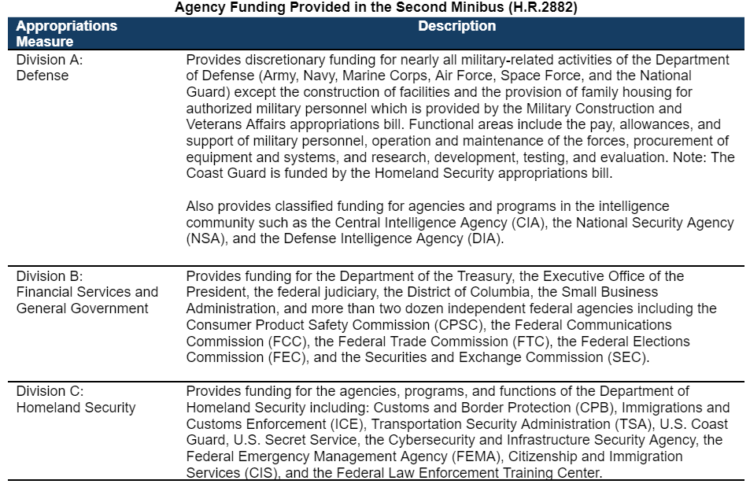
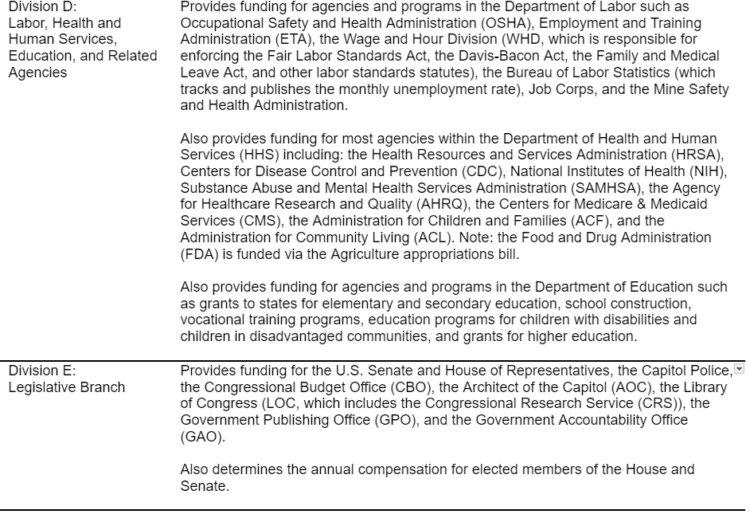

The Second 6-Bill Minibus Appropriates Roughly Three-Quarters of All Discretionary Spending for FY 2024
According to the cost estimate prepared by the nonpartisan Congressional Budget Office (CBO), the minibus would appropriate a grand total of $1,185.3 billion in discretionary budget authority for FY 2024. However, this amount includes $2.8 billion in emergency-designated spending provided by legislation enacted prior to last year’s Fiscal Responsibility Act—funding that will not count towards enforcement of the FY 2024 spending caps. For purposes of the caps, H.R.2882 appropriates $1,182.4 billion in new budget authority, roughly three-quarters of total discretionary spending subject to the FY 2024 caps.
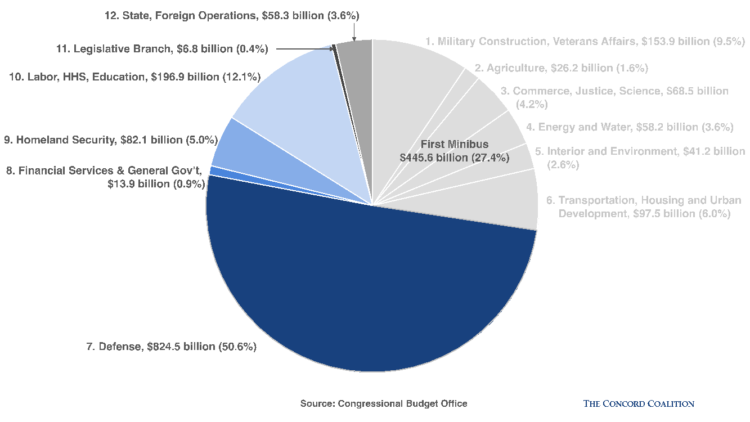
Comparisons to FY 2023 Levels are Obscured by One-Offs and Budget Gimmicks
The table below compares discretionary spending levels in the second 6-bill minibus with FY 2023, using publicly available data. A true apples-to-apples comparison is complicated, however, by one-off changes, side deals, and budget gimmicks that skew the data (see notes).
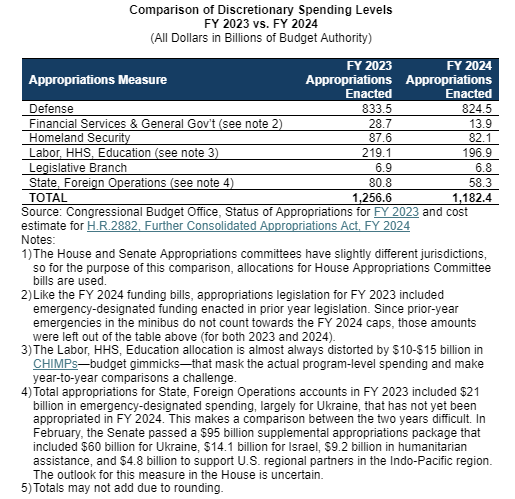
How Does this Minibus Rack Up Against the Spending Caps for FY 2024?
The FRA established two spending caps for FY 2024—one for defense-related discretionary spending and one for non-defense. While some agencies receive funding from just one bucket (e.g., the LHHS bill does not contain any defense-related spending), some receive funding from both buckets (e.g., the Homeland Security title includes both defense-related and nondefense appropriations). The following figure illustrates how the two minibus appropriations bills stacked up in relation to the FY 2024 caps:
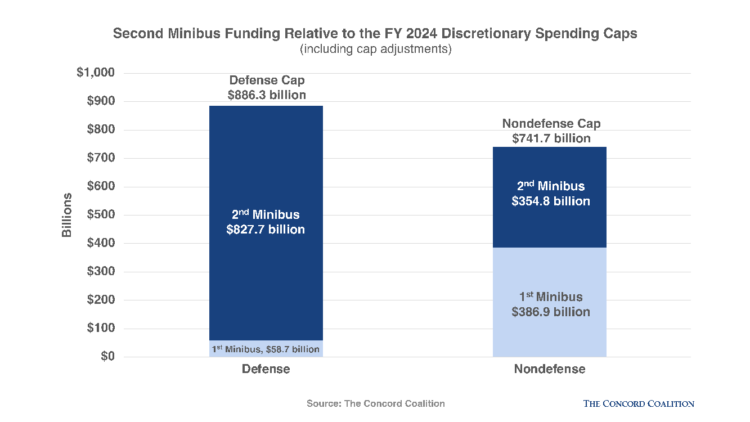
Is There Anything Else in the Minibus?
Policy riders. Although there are Senate rules against “legislating” in an appropriation bill (i.e., setting new policy in an appropriations bill), if the House does it first, the Senate prohibitions get harder to enforce. Unfortunately, as the culture wars in domestic politics have escalated, so too has the prevalence of policy riders in appropriations legislation. Moreover, it’s often the riders that hamstring the budget process, not the actual spending levels.
This year, policy riders pertaining to immigration, abortion, gun rights, and more threatened to derail the appropriations process—right up until the day before the funding deadline. In February, conservative Republicans delivered a list of demands to Speaker Mike Johnson for him to secure as part of the FY 2024 appropriations negotiations. Of these, Republicans secured language prohibiting taxpayer funding for the United Nations Relief and Works Agency (UNRWA), an agency accused of employing members of Hamas who helped coordinate the October attack on Israel.
Earmarks. The second FY 2024 minibus contains approximately 1,400 congressionally directed spending projects (“earmarks”) totaling approximately $1.9 billion. The earmarks are disclosed in tables in the explanatory reports that go along with each section of the bill. For example, LHHS appropriations earmarks are here.
The rationale for restoring Congressional earmarks in the 117th Congress was to make the appropriations process run more smoothly. It used to be that earmarks assured support for the underlying measure. In the current climate, however, some lawmakers unabashedly “vote ‘NO’ yet take the dough.”
What Happens Next?
Although Congress has completed the regular discretionary appropriations process for FY 2024, a supplemental appropriations bill awaits consideration in the House. In February, the Senate passed bipartisan legislation that would provide $95 billion in additional security-related appropriations for global hotspots: $60 billion for Ukraine, $14.1 billion for Israel, $9.2 billion in humanitarian assistance, and $4.8 billion to support U.S. regional partners in the Indo-Pacific region. This money would be available to spend in FY 2024, adding to the totals above. Speaker Johnson said he expects the House will consider one or more supplemental aid packages when the chamber reconvenes in April.
In addition, the recent collapse of the Francis Scott Key bridge near the Port of Baltimore will demand attention from appropriators this spring/summer. Baltimore is the top domestic port for auto imports and a major hub for other goods such as forest products, farm equipment, and sugar. To avoid major supply chain disruptions (and regional economic calamity), the Biden Administration will be eager to expedite the clean-up and salvage efforts, reopen the port, and rebuild the bridge as fast as possible which will require federal financial support, perhaps in the billions.
Lastly, House and Senate appropriators are poised to begin work on the FY 2025 appropriations bills when lawmakers return to Washington, D.C. after the Easter holiday. Normally, the next step in the FY 2025 process would be to pass a Congressional budget resolution, but the top line discretionary numbers for 2025 have already been established (by the Fiscal Responsibility Act), eliminating a major incentive to adopt a bicameral spending blueprint. The House and Senate are unlikely to complete all 12 appropriations before the start of the FY 2025 fiscal year on October 1, however, necessitating yet another short-term spending patch—perhaps into mid-December, after the outcome of the November election is known.
Only 185 days until the next potential government funding lapse…




